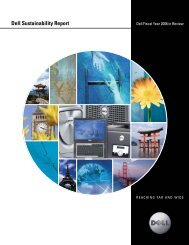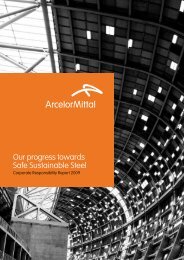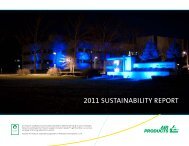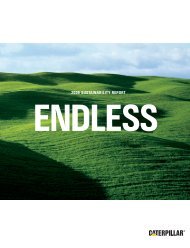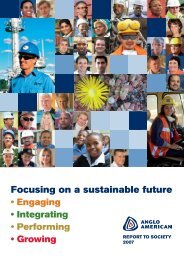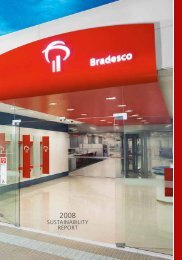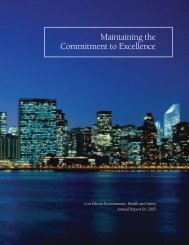Blueprint for Sustainability - Corporate - Ford Motor Company
Blueprint for Sustainability - Corporate - Ford Motor Company
Blueprint for Sustainability - Corporate - Ford Motor Company
- No tags were found...
Create successful ePaper yourself
Turn your PDF publications into a flip-book with our unique Google optimized e-Paper software.
i5Vehicle safety 39Safer VehiclesAccident Avoidance TechnologiesA variety of technologies, in addition to a vehicle’s basic handlingand braking capabilities, can help drivers avoid accidents. Thesetechnologies are generally not necessary <strong>for</strong> attentive drivers inmost road conditions, but may provide added benefits <strong>for</strong> driverswho become distracted or experience challenging road conditions.Our industry-leading innovation known as Roll Stability Control(RSC) continues to give drivers more confidence in emergencysituations. <strong>Ford</strong> and its global brands have built more than 4million vehicles globally with electronic stability control systems.To date, more than 1 million of those vehicles featureAdvanceTrac ® with Roll Stability Control, which activelymeasures and helps control both yaw and roll movements.RSC was first introduced on the 2003 Volvo XC90 and is nowstandard equipment on the <strong>Ford</strong> Explorer, SportTrac, Expedition,Edge and new 2008 Escape, as well as E-series Wagons withthe 5.4L engine. It is also standard on the Mercury Mountaineer,the new 2008 Mariner, Lincoln Navigator and Lincoln MKX. <strong>Ford</strong>is developing a next-generation regenerative braking system <strong>for</strong>the 2009 Escape Hybrid and Mariner Hybrid to be compatiblewith RSC.Another <strong>Ford</strong> safety innovation is the next generation of adaptiveheadlamps. With a unique two-part optics package, the AdaptiveFront Lighting System (AFLS) is an industry breakthrough thatallows drivers to see better at night around curves in the road.Most cornering, or swivel, lighting systems are one-piecemodules that turn as a single unit with the vehicle as itapproaches a curve. In contrast, the AFLS incorporates twoindependent light sources: a high-output halogen projector <strong>for</strong>the main beam and a secondary row of light-emitting diodes thatilluminates almost instantaneously, distributes the light beamevenly and consumes less power than conventional lights.Flaura Koplin-WinstonDennis DurbinChildren are not small adults.We can’t take what we learnfrom adult injury preventionand transfer it to childrenand teens without makingadaptations that suit theirneeds. Because children arethe primary occupants ofthe second and third rows invehicles, automakers need tooptimize restraints <strong>for</strong> them.Auto companies should alsofind ways to promote safe andresponsible teen driving.X1 Toolkit overview2 The logo3 Colour Palette4 Typefaces5 Icons5.1 How the icons are used6 Graphs and charts7 The artworks8 Supporting in<strong>for</strong>mation9 Contact detailsWhere can I find these icons?If you would like any of these icons or <strong>for</strong> a newicon to be created please contact the Brand team,$CMIG brand enquiry.Flaura Koplin-Winston Co-Scientific Director and Founder.Dennis Durbin Co-Scientific Director. Both of Center <strong>for</strong> Injury Researchand Prevention, The Children’s Hospital of PhiladelphiaIn<strong>for</strong>mation Top 10factsLanguageglossaryQuestion Answer Do Don’t ExclamationDirectionalsignpostCommunityaffairsQuote ContacttelephoneContact fax ContactemailContactaddressInternalactivitiesThe icon libraryContents<strong>Ford</strong> is also developing a suite of accident avoidance featuresthat use <strong>for</strong>ward-looking radar and vision sensors. AdaptiveCruise Control (ACC), <strong>for</strong> example, helps drivers maintain a safedistance from the vehicle in front of them. It is one of theinnovations available on the Volvo S80, XC70 and V70, as wellas the <strong>Ford</strong> Mondeo, S-MAX and Galaxy. While primarily acom<strong>for</strong>t and convenience feature, ACC also contributes to morecontrolled driving when traffic flow is uneven. The ACC moduleis mounted at the front of the vehicle and uses radar to measurethe gap and closing speed to the vehicle ahead. The systemautomatically adjusts the speed of the car to help maintain apre-set distance from the vehicle in front.Forward Collision Warning (FCW) with Auto Brake comes as partof the ACC package and uses radar technology to help avoid ormitigate the effects of rear-end collisions. If the FCW-equippedvehicle approaches another moving vehicle from behind and thedriver does not react, a bank of red LED warning indicatorsflashes on the windscreen and an audible warning signal isactivated. Forward Collision Warning is designed to providesufficient time <strong>for</strong> the driver to react and avoid the hazard. If therisk of collision increases despite the warning, Auto Brake isactivated. The Auto Brake system supports driver-initiatedbraking by pre-charging the brakes and preparing <strong>for</strong> panicbrake application.Driver Alert Control and Lane Departure Warning are two otherfeatures recently launched on the Volvo S80, V70 and XC70.These systems, which are designed to combat driver fatigue,use a <strong>for</strong>ward-looking camera to continuously monitor the roadand keep track of where the car is in relation to the lanemarkings. If the driver loses concentration or the vehicle’swheels move outside the lane markings, a warning chime alertsthe driver.Occupant Protection TechnologiesThe <strong>Ford</strong> Personal Safety System helps reduce the risk of injuryto the driver and front passenger in the event of a moderate tosevere frontal collision. The system is designed to adjust thedeployment of the front air bags to enhance protection <strong>for</strong> frontseatoccupants. It accomplishes this with the help of crashseverity sensors, safety belt usage sensors, dual-stage driver andfront-passenger air bags, a driver’s seat position sensor and frontoutboard safety belt pretensioners. The Personal Safety Systemis standard on <strong>Ford</strong> vehicles in the U.S.The <strong>Ford</strong> Explorer and Mercury Mountaineer are equipped withadditional features to enhance occupant protection during aside-impact event. Side-impact air bags mounted in theoutboard side of each front seat enhance chest-area protection,and roof-mounted side curtains enhance head protection. Bothare standard on many <strong>Ford</strong> vehicles. Door armrests and doortrim also provide abdomen and lower torso cushions, and afour-inch-thick foam block inside each door helps to manageside-impact <strong>for</strong>ces on occupants’ hips.INTRODUCTION GOVERNANCE CLIMATE CHANGE MOBILITY HUMAN RIGHTS VEHICLE SAFETY SUSTAINING FORD CONCLUSIONFor more in<strong>for</strong>mation visit:www.<strong>for</strong>d.com/go/sustainability





